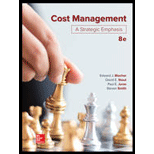
1.
Calculate the variances.
1.
Explanation of Solution
Calculate the standard factory
For variable factory overhead:
Therefore, the variable factory overhead per hour is $6.
For fixed factory overhead:
Therefore, the fixed factory overhead per hour is $5.
a) Calculate the variable overhead spending variance:
Therefore, the spending variance is $6,000 F.
b) Calculate the variable overhead efficiency variance:
Therefore, the efficiency variance is $9,000 U.
Calculate the budgeted fixed manufacturing overhead per month:
c) Calculate the fixed overhead spending variance:
Therefore, the spending variance is $10,000 U.
d) Calculate the fixed overhead production volume variance:
Therefore, the production volume variance is $10,000 F.
e) Calculate the total amount of under or over applied:
Therefore, the total amount of under applied overhead is $3,000.
2.
Journalize the following.
2.
Explanation of Solution
Journalize the following:
| Date | Title and explanation | Debit ($) | Credit ($) |
| Variable factory overhead | 315,000 | ||
| Utilities payable | 315,000 | ||
| (To record the actual variable overhead costs for the period) | |||
| WIP inventory | 312,000 | ||
| Variable factory overhead | 312,000 | ||
| (To record the standard variable overhead costs to production) | |||
| Variable factory overhead | 312,000 | ||
| Variable overhead efficiency variance | 9,000 | ||
| Variable overhead spending variance | 6,000 | ||
| Variable factory overhead | 315,000 | ||
| (To record the variable overhead variance for the period) | |||
| Fixed factory overhead | 260,000 | ||
| Salaries payable, accumulated | 260,000 | ||
| (To record actual fixed overhead costs for the period) | |||
| WIP inventory | 260,000 | ||
| Fixed factory overhead | 260,000 | ||
| (To record the standard fixed overheads costs to production) | |||
| Fixed factory overhead | 260,000 | ||
| Fixed factory overhead spending variance | 10,000 | ||
| Production volume variance | 10,000 | ||
| Fixed factory overhead | 260,000 | ||
| (To record the fixed overhead variances for the period) |
Table (1)
3.
Journalize the closing entry.
3.
Explanation of Solution
Journalize the closing entry:
| Date | Particulars | Debit ($) | Credit ($) |
| Variable overhead spending variance | 6,000 | ||
| Production volume variance | 10,000 | ||
| Cost of goods sold | 3,000 | ||
| Variable overhead efficiency variance | 9,000 | ||
| Fixed overhead spending variance | 10,000 | ||
| (To record the closing entry) |
Table (2)
4.
Determine the manner in which the provisions of GAAP regarding inventory costing is applicable to the end of period variance deposition.
4.
Explanation of Solution
The GAAP specifies the usage of normal capacity for establishing fixed overhead allocation rates and when unallocated overhead are recognized, it will be treated as an expense for that period. While there is no clarity then, the GAAP suggests that the unallocated overhead will be treated as abnormal period cost.
5.
Describe the manner of managing the reported earnings under absorption costing under the method of disposing the fixed overhead cost variances during the year-end.
5.
Explanation of Solution
The fixed overhead costs absorbed from the inventory are affected by the denominator that is selected to compute the pre-determined fixed overhead application rate. The denominator volume affects the amount of production volume variance for the period. The effect of the change in physical inventory can be intensified or reduced depending on the manner in which the production volume variance is disposed at the end of the period. Moreover, the ability to affect the reported income is confined to the circumstance in which the production volume variance is written off. Following are the manner in which it is written off to the cost of goods sold:
- When the inventory is increasing, a lower volume level will boost up the increase in absorption costing income due to the deferral of fixed overhead in inventory.
- In case inventory is decreasing, a higher denominator level will moderate a decrease in the absorption-costing income. This is because of the release of fixed overhead into the cost of goods sold.
Therefore, the interaction of the fixed overhead rate is set and the manner in which the resulting production volume variance is accounted for that provides management an opportunity to manage the earnings under absorption costing. Following are the ways in which managers can increase the short-run operating income:
- Choose a larger denominator level in case the inventory is expected to decrease.
- Choose a smaller denominator level in case the inventory is expected to increase.
When the production volume variance is prorated based on the units that create a variance, the denominator-level choice has no effect on the absorption costing income. This is due to the reason that prorating such a variance effectively changes the budgeted overhead application rate with respect to the actual overhead rate.
Want to see more full solutions like this?
Chapter 15 Solutions
Cost Management

 AccountingAccountingISBN:9781337272094Author:WARREN, Carl S., Reeve, James M., Duchac, Jonathan E.Publisher:Cengage Learning,
AccountingAccountingISBN:9781337272094Author:WARREN, Carl S., Reeve, James M., Duchac, Jonathan E.Publisher:Cengage Learning, Accounting Information SystemsAccountingISBN:9781337619202Author:Hall, James A.Publisher:Cengage Learning,
Accounting Information SystemsAccountingISBN:9781337619202Author:Hall, James A.Publisher:Cengage Learning, Horngren's Cost Accounting: A Managerial Emphasis...AccountingISBN:9780134475585Author:Srikant M. Datar, Madhav V. RajanPublisher:PEARSON
Horngren's Cost Accounting: A Managerial Emphasis...AccountingISBN:9780134475585Author:Srikant M. Datar, Madhav V. RajanPublisher:PEARSON Intermediate AccountingAccountingISBN:9781259722660Author:J. David Spiceland, Mark W. Nelson, Wayne M ThomasPublisher:McGraw-Hill Education
Intermediate AccountingAccountingISBN:9781259722660Author:J. David Spiceland, Mark W. Nelson, Wayne M ThomasPublisher:McGraw-Hill Education Financial and Managerial AccountingAccountingISBN:9781259726705Author:John J Wild, Ken W. Shaw, Barbara Chiappetta Fundamental Accounting PrinciplesPublisher:McGraw-Hill Education
Financial and Managerial AccountingAccountingISBN:9781259726705Author:John J Wild, Ken W. Shaw, Barbara Chiappetta Fundamental Accounting PrinciplesPublisher:McGraw-Hill Education





